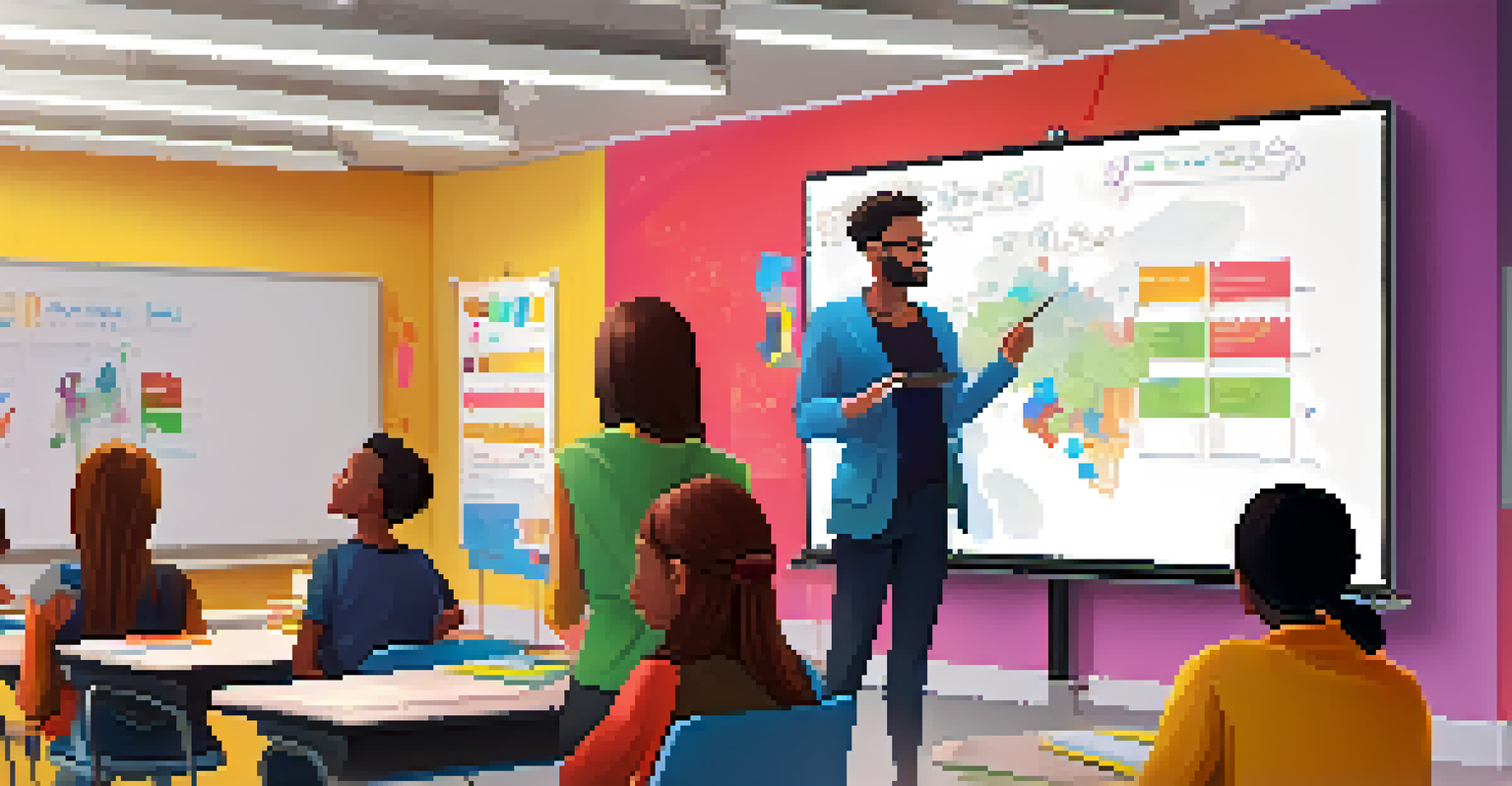Evaluating the Effectiveness of Flipped Classroom Models

Understanding the Flipped Classroom Model
The flipped classroom model reimagines traditional teaching by reversing the roles of in-class and homework activities. Instead of introducing new concepts during class time, students learn the material at home through videos or readings. This shift allows for more interactive and hands-on learning during class hours, where teachers can facilitate discussions and activities that deepen understanding.
The only way to learn mathematics is to do mathematics.
Imagine a world where lectures are watched like Netflix shows, and class time becomes a collaborative workshop. This model not only makes learning more accessible but encourages students to take responsibility for their education. By engaging with the content at their own pace, learners can revisit complex topics as needed, leading to enhanced comprehension.
However, adopting a flipped classroom isn't just about switching where learning happens; it requires careful planning and resource allocation. Educators must curate quality materials and ensure that students have the necessary technology access. The effectiveness of this model largely depends on how well these elements are executed.
Benefits of Flipped Classrooms for Students
One of the standout benefits of flipped classrooms is the promotion of personalized learning. With the ability to control their pace, students can spend more time on challenging topics while advancing quickly through areas they grasp easily. This flexibility caters to diverse learning styles and abilities, ensuring that no one gets left behind.

Additionally, flipped classrooms encourage active engagement and participation. When class time is dedicated to discussions and projects, students are more likely to collaborate and communicate with their peers. This interactive environment fosters critical thinking and problem-solving skills, which are essential for real-world applications.
Flipped Classrooms Redefine Learning
By reversing traditional roles, flipped classrooms enable students to learn at their own pace at home and engage in deeper discussions during class.
Moreover, students often report feeling more prepared for class discussions and activities. With the foundational knowledge acquired at home, they can dive deeper into the subject matter during class hours. This preparation not only boosts their confidence but also enhances the overall classroom dynamic.
Challenges Faced in Flipped Classroom Implementation
While the benefits are enticing, implementing a flipped classroom model comes with its own set of challenges. One significant hurdle is ensuring that all students have access to the necessary technology and resources at home. Without a reliable internet connection or devices, the model's effectiveness can quickly diminish.
Education is not the filling of a pail, but the lighting of a fire.
Furthermore, not all students may be motivated to engage with the material independently. Some learners thrive in structured environments and may struggle without the direct guidance of a teacher. This lack of motivation can lead to gaps in understanding, which could impact their performance during in-class activities.
Lastly, teachers themselves may face a steep learning curve when adapting to this new teaching style. Developing high-quality instructional videos and planning engaging in-class activities requires time and effort. Professional development and support are crucial to ensure educators feel equipped to succeed in this model.
Evaluating Student Outcomes in Flipped Classrooms
Assessing the effectiveness of flipped classrooms hinges on measuring student outcomes. Various studies have indicated that students in flipped classroom settings often perform better academically compared to traditional models. Improved test scores and higher engagement levels are common indicators of success in this innovative educational approach.
However, evaluation should go beyond just academic performance. It's essential to consider student attitudes and self-efficacy as well. Surveys and feedback mechanisms can provide valuable insights into how learners perceive their experience in a flipped classroom, helping educators refine their strategies.
Personalized Learning Benefits
Flipped classrooms promote personalized learning, allowing students to focus on challenging topics while fostering active engagement and collaboration.
Additionally, tracking long-term retention of knowledge can offer a deeper understanding of the model's effectiveness. Observing how well students recall and apply learned concepts in subsequent courses can reveal whether the flipped approach truly enhances learning.
Pedagogical Techniques for Flipped Classrooms
To maximize the effectiveness of flipped classrooms, educators can employ a variety of pedagogical techniques. For instance, incorporating multimedia resources such as podcasts, videos, and interactive quizzes can cater to different learning preferences. This variety not only keeps students engaged but also reinforces the material through multiple formats.
Another effective technique is the use of collaborative projects during class time. By working in groups, students can apply what they've learned, share insights, and learn from each other. This peer-to-peer interaction often leads to deeper understanding and retention of concepts.
Regular formative assessments are also crucial in a flipped classroom setting. By gauging student understanding through quizzes or discussions, teachers can identify areas that need further clarification and adjust their lesson plans accordingly, ensuring that all students are on the same page.
Technology's Role in Flipped Classrooms
Technology is a cornerstone of the flipped classroom model, enabling students to access learning materials outside of the classroom. Platforms like Google Classroom, Edpuzzle, or even YouTube serve as valuable resources for hosting instructional videos and interactive content. The right tech tools can make the learning process seamless and engaging.
Moreover, technology allows for tracking student engagement and progress, providing educators with insights into how well students are consuming the material. Analytics can show which videos are most viewed or where students tend to struggle, allowing for tailored support.
Challenges in Implementation
Despite the benefits, challenges like technology access and student motivation must be addressed for the successful adoption of the flipped classroom model.
However, it's essential to remember that technology should enhance, not overshadow, the learning experience. A balance between digital resources and traditional teaching methods can create a more effective educational environment.
Future Perspectives on Flipped Classrooms
As education continues to evolve, the flipped classroom model is likely to gain traction in various learning environments. The shift towards hybrid and remote learning has highlighted the importance of flexibility and student-centered approaches. Flipped classrooms align well with these trends, offering a viable solution in the ever-changing landscape of education.
Moreover, with advancements in technology, the resources available for flipped classrooms will only improve. Virtual reality, AI-driven learning platforms, and personalized learning experiences may become integral components of this model, further enhancing its effectiveness.

Ultimately, the success of the flipped classroom will rely on continuous evaluation and adaptation. Educators must remain open to feedback and willing to experiment with new strategies to ensure they meet the needs of their students in this dynamic educational environment.